
|
About
Madison
Country : United
States of America
State : Ohio
County : Lake
County
Population:3.088
(estimated
in July 2006)
|

|
The village
of Madison, Ohio is located approximately 40 miles northeast of the city
of Cleveland. It is the population center of the Township bearing the same
name which forms the eastern corner of Lake County, Ohio.
Around the time
that the first legal/political geographic boundaries were being drawn in
the area, James Madison was President of the United States, and Madison
township was named in his honor.
|
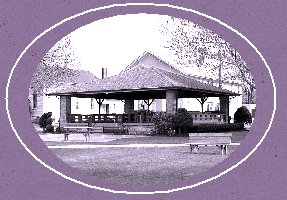 |
The area
where Madison village now stands was originally named "Chapinville" after
the Chapin family who were the first to settle there.
By 1811
the village had grown sufficiently to optimistically rename it as "Centerville."
|
however, that
the name “Madison” was ultimately adopted.
|
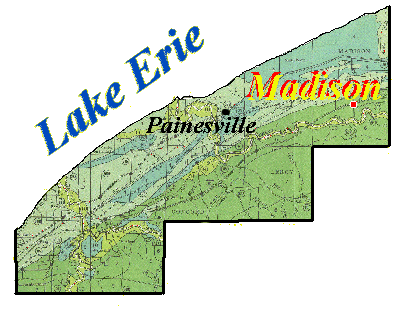 |
The
early businesses that started here were similar to those in demand throughout
the region to meet essential needs of homesteaders in the isolated and
sparsely populated frontier. These included sawmills, blacksmith shops,
tanneries and bootmakers, furniture and carriage builders, dry goods and
grocery stores, and even such "luxuries" as millineries, apothecaries and
meat markets.
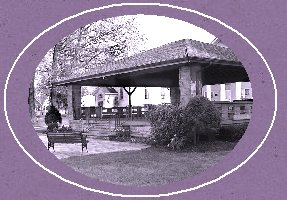
|
Reflecting
their New England origins and values, most of the early settlers were strongly
religious and prioritized community institutions and education as essential
elements of “civilization.” In 1816 three and one half acres of land known
as “the Commons” was purchased and set aside for the future construction
of schools, churches and a town hall. It is this park area in the central
area of the village where the present-day Madison bandstand now resides.
|
 |
The greatest boon
to early growth was the discovery of iron ore deposits in bogs near Madison
village. This bog iron was easy to mine and charcoal could be produced
from the local hardwoods, so iron furnaces became one of the most important
early industries.
A company called
Arcole Furnace was formed and by 1834 had became the largest industry in
Ohio, employing 2000 men and producing between 1,000 and 1,500 tons of
iron per year.
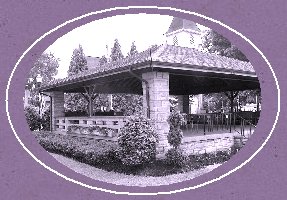
|
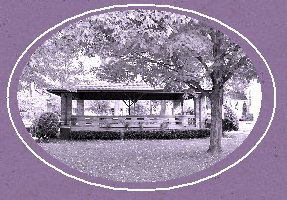
The plowshares,
anvils, "Buckeye Stoves" and myriad other products molded here found their
way to markets in the surrounding states and Canada.
|
The Arcole
blast furnaces operated for more than 20 years before the iron deposits
ran out in the 1850s. The influx of laborers to operate the mill brought
about a housing boom, along with the building of hotels and boarding houses,
taverns, distilleries and breweries.
|
|
|
|
The
closing of the Arcole mills necessitated Madison township to revert to
an agricultural economy after 1850, but wisely Madison chose to move into
the new and specialized area of commercial horticulture.
Large nurseries
growing specimen trees and floral plantings found markets across the entire
northeastern quarter of the U.S. and became the new economic foundation
of the Madison area.
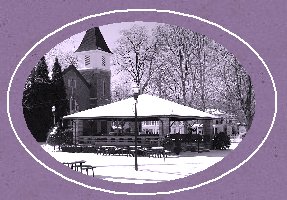
|
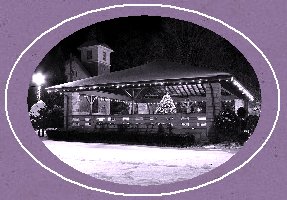
The shallow
valleys inland from Lake Erie also proved very amenable to vineculture,
and later, in the 20th century, a number small estate wineries were successfully
established.
|
These continue
to expand and encourage additional start-ups to the present day.

|
Through
the efforts of the Madison Historical Society, a number of historic homes
in the Madison area have been identified and registered as National Historic
Landmarks, including some that played an historic role in the famous “Underground
Railroad” network preceding the American Civil War. A few architecturally
notable old mansions in Madison have been refurbished as upscale bed and
breakfast establishments, reflecting and helping promote the growing appreciation
of the little village as a base from which tour the many attractions within
the region. Adding to the charm of the village is its town green with its
gardens and monuments.... and of course its attractive bandstand.
As
can be seen in the photographs, the bandstand at Madison is rather distinctive
in comparison to most others in the area.
It's
broad, square footprint and masonry construction give it a pavilion-like
appearance but this has the advantage of expanding its usefulness for functions
of many types besides the staging of musical performances. In fact, Madison
does not offer the usual schedule of regularly scheduled concerts through
the summer months like many other nearby communities.
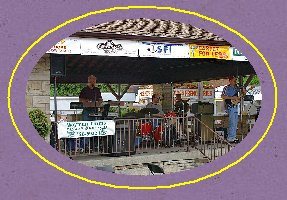 |
Instead,
expenses are concentrated on presenting a music festival within the framework
of the annual town festival known as “Madison Old Fashioned Days.” Other
elements of this festival include activities such as parades, art and craft
exhibits, a classic car show, contests of all sorts, and dining experiences
from the scores of food concessionaires
|
|

who
encamp around the "Commons" for the duration of the event.
|
It
is a very popular attraction that temporarily triples the village population.
|
| |
|
Crédits
|

|
Links
|
|
Pictures
and information
|
Vic Cooke
|
pbase
Artist Vic Cooke
|

|
 |
To see it
on Google-Earth
|
Lattitude
: 41.7007
|
|
Longitude
: -81.049
|
|
|

|
|
|